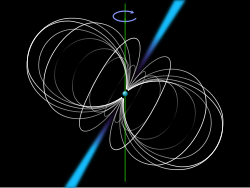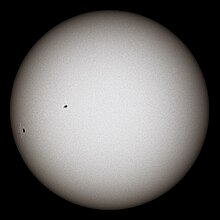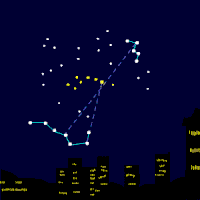Portal:Stars
IntroductionA star is a luminous spheroid of plasma held together by self-gravity. The nearest star to Earth is the Sun. Many other stars are visible to the naked eye at night; their immense distances from Earth make them appear as fixed points of light. The most prominent stars have been categorised into constellations and asterisms, and many of the brightest stars have proper names. Astronomers have assembled star catalogues that identify the known stars and provide standardized stellar designations. The observable universe contains an estimated 1022 to 1024 stars. Only about 4,000 of these stars are visible to the naked eye—all within the Milky Way galaxy. A star's life begins with the gravitational collapse of a gaseous nebula of material largely comprising hydrogen, helium, and trace heavier elements. Its total mass mainly determines its evolution and eventual fate. A star shines for most of its active life due to the thermonuclear fusion of hydrogen into helium in its core. This process releases energy that traverses the star's interior and radiates into outer space. At the end of a star's lifetime as a fusor, its core becomes a stellar remnant: a white dwarf, a neutron star, or—if it is sufficiently massive—a black hole. Stellar nucleosynthesis in stars or their remnants creates almost all naturally occurring chemical elements heavier than lithium. Stellar mass loss or supernova explosions return chemically enriched material to the interstellar medium. These elements are then recycled into new stars. Astronomers can determine stellar properties—including mass, age, metallicity (chemical composition), variability, distance, and motion through space—by carrying out observations of a star's apparent brightness, spectrum, and changes in its position in the sky over time. Stars can form orbital systems with other astronomical objects, as in planetary systems and star systems with two or more stars. When two such stars orbit closely, their gravitational interaction can significantly impact their evolution. Stars can form part of a much larger gravitationally bound structure, such as a star cluster or a galaxy. (Full article...) Selected star - Photo credit: ESO/P. Kervella
Betelgeuse is a semiregular variable star located approximately 640 light-years from the Earth. With an apparent magnitude ranging between 0.3 and 1.2, it is the ninth brightest star in the night sky. Although Betelgeuse has the Bayer designation Alpha Orionis (α Orionis / α Ori), it is most often the second brightest star in the constellation Orion behind α; Rigel (Beta Orionis) is usually brighter (Betelgeuse is a variable star and is on occasion brighter than Rigel). The star marks the upper right vertex of the Winter Triangle and center of the Winter Hexagon. Betelgeuse is a red supergiant, and one of the largest and most luminous stars known. For comparison, if the star were at the center of the Solar System its surface might extend out to between the orbits of Mars and Jupiter, wholly engulfing Mercury, Venus, the Earth and Mars. The angular diameter of Betelgeuse was first measured in 1920–1921 by Albert Abraham Michelson and Francis G. Pease using the 100 inch (2.5 m) John D. Hooker astronomical interferometer telescope atop Mount Wilson Observatory. Astronomers believe Betelgeuse is only a few million years old, but has evolved rapidly because of its high mass. Due to its age, Betelgeuse may go supernova within the next millennium (because it is hundreds of light years away, it possibly may have done so already). Selected article - Photo credit: User:Mysid and User:Jm smits
Pulsars are highly magnetized, rotating neutron stars that emit a beam of electromagnetic radiation. The observed periods of their pulses range from 1.4 milliseconds to 8.5 seconds. The radiation can only be observed when the beam of emission is pointing towards the Earth. This is called the lighthouse effect and gives rise to the pulsed nature that gives pulsars their name. Because neutron stars are very dense objects, the rotation period and thus the interval between observed pulses is very regular. For some pulsars, the regularity of pulsation is as precise as an atomic clock. A few pulsars are known to have planets orbiting them, such as PSR B1257+12. Werner Becker of the Max Planck Institute for Extraterrestrial Physics said in 2006, "The theory of how pulsars emit their radiation is still in its infancy, even after nearly forty years of work. The events leading to the formation of a pulsar begin when the core of a massive star is compressed during a supernova, which collapses into a neutron star. The neutron star retains most of its angular momentum, and since it has only a tiny fraction of its progenitor's radius (and therefore its moment of inertia is sharply reduced), it is formed with very high rotation speed. A beam of radiation is emitted along the magnetic axis of the pulsar, which spins along with the rotation of the neutron star. The magnetic axis of the pulsar determines the direction of the electromagnetic beam, with the magnetic axis not necessarily being the same as its rotational axis. This misalignment causes the beam to be seen once for every rotation of the neutron star, which leads to the "pulsed" nature of its appearance. The beam originates from the rotational energy of the neutron star, which generates an electrical field from the movement of the very strong magnetic field, resulting in the acceleration of protons and electrons on the star surface and the creation of an electromagnetic beam emanating from the poles of the magnetic field. This rotation slows down over time as electromagnetic power is emitted. When a pulsar's spin period slows down sufficiently, the radio pulsar mechanism is believed to turn off (the so-called "death line"). As this seems to take place after ~10-100 million years, but neutron stars have been formed throughout the ~13.6 billion year age of the universe, more than 99% of neutron stars are thought to no longer be pulsars. To date, the slowest observed pulsar has a period of 8 seconds. Selected image - Photo credit: ESA/Hubble
The Large Magellanic Cloud (LMC) is a nearby irregular galaxy, once thought to be a satellite of our own. At a distance of slightly less than 50 kiloparsecs (≈ 160,000 light-years), the LMC is the third closest galaxy to the Milky Way, with the Sagittarius Dwarf Spheroidal and Canis Major Dwarf Galaxy, lying closer to the center of the Milky Way. It has a mass equivalent to approximately 10 billion times the mass of our Sun (1010 solar masses), making it roughly 1/10 as massive as the Milky Way, and a diameter of about 14,000 light-years, though the LMC is the fourth largest galaxy in the Local Group. Did you know?
SubcategoriesTo display all subcategories click on the ►
Selected biography - Photo credit: NASA
Stephen William Hawking, CH, CBE, FRS, FRSA (8 January 1942 – 14 March 2018) was an English theoretical physicist, cosmologist, and author who was director of research at the Centre for Theoretical Cosmology at the University of Cambridge. Between 1979 and 2009, he was the Lucasian Professor of Mathematics at Cambridge, widely viewed as one of the most prestigious academic posts in the world. Hawking was born in Oxford into a family of physicians. In October 1959, at the age of 17, he began his university education at University College, Oxford, where he received a first-class BA degree in physics. In October 1962, he began his graduate work at Trinity Hall, Cambridge, where, in March 1966, he obtained his PhD degree in applied mathematics and theoretical physics, specialising in general relativity and cosmology. In 1963, at age 21, Hawking was diagnosed with an early-onset slow-progressing form of motor neurone disease that gradually, over decades, paralysed him. After the loss of his speech, he communicated through a speech-generating device, initially through use of a handheld switch, and eventually by using a single cheek muscle. Hawking's scientific works included a collaboration with Roger Penrose on gravitational singularity theorems in the framework of general relativity, and the theoretical prediction that black holes emit radiation, often called Hawking radiation. Initially, Hawking radiation was controversial. By the late 1970s, and following the publication of further research, the discovery was widely accepted as a major breakthrough in theoretical physics. Hawking was the first to set out a theory of cosmology explained by a union of the general theory of relativity and quantum mechanics. He was a vigorous supporter of the many-worlds interpretation of quantum mechanics. Hawking achieved commercial success with several works of popular science in which he discussed his theories and cosmology in general. His book A Brief History of Time appeared on the Sunday Times bestseller list for a record-breaking 237 weeks. Hawking was a Fellow of the Royal Society, a lifetime member of the Pontifical Academy of Sciences, and a recipient of the Presidential Medal of Freedom, the highest civilian award in the United States. In 2002, Hawking was ranked number 25 in the BBC's poll of the 100 Greatest Britons. He died in 2018 at the age of 76, having lived more than 50 years following his diagnosis of motor neurone disease. (Full article...) Topics |


